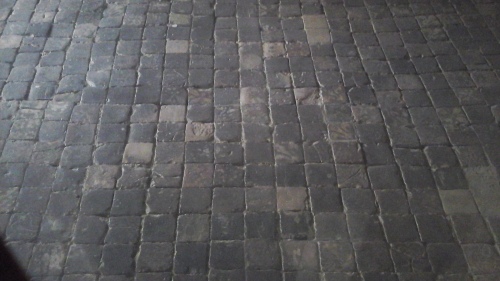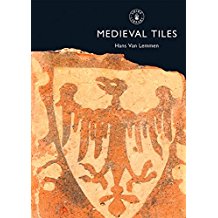If you’ve been reading this blog for a while, you know that I’m interested in medieval floors in general and medieval tiles in particular. Tiles were very expensive, as they took a long time and a great deal of skill to make. They were mostly used in ecclesiastical buildings, although some people, like Laurence of Ludlow, were wealthy enough to be able to afford to have them in their houses.

Medieval floor tiles, Stokesay Castle
When I saw Van Lemmen’s book in the English Heritage shop at Stokesay Castle, there was never any doubt that I was going to buy it. There are only 40 pages, but those pages are glorious. Since most of the pages are full of colour photographs and drawings of medieval tiles, there is not much room for scholarly text.
The photographs in this post are not from the book, they’re mine. The ones in the book are much better.

Fourteenth century tiles, St Bartholomew’s, Hyde
Such text as there is is very informative, although I would love to know more about how tiles were made. There is a wonderful drawing of a fourteenth century kiln, which highlights what a hit and miss affair tilemaking could be. An imperceptible flaw could destroy a tile and it would be several days before this would be known. It took about six days to load, fire and unload the kiln. A medieval kiln looked like an earthwork. Given the number of days it took to fire a tile, there was no point in making them small. It was sensible to make as many tiles as you could.

Medieval Tiles, St Mary’s Guildhall, Coventry
Until I read the book, I wasn’t aware that mosaics were made in fourteenth century England. There are some lovely examples in the book from Rievaulx and Byland Abbeys. I can’t share the exact photos with you, but those links are to other photos of the mosaics in question.
It is the pictures which make the book worth buying. They include many examples of medieval tiles from all over England. My favourite photograph is one showing Diana Hall’s modern replacements of damaged tiles in Winchester Cathedral. Her tiles have the colour and vibrancy that all medieval tiles must have had when first laid.
Making tiles was incredibly labour intensive and here are two videos showing how much time it could take just to get the clay into the moulds.
The first is from Guédelon, where a castle is being built in Burgundy using thirteenth century techniques. The second is a documentary about Diana Hall and her life as a tilemaker.




When I visit any historical building I’ll always look up first and then down at the floor. So many people concentrate on the bit in the middle, the walls and windows, tapestries, and furniture, but I find the floors and ceilings show the most incredible artwork. It must have been such a satisfying job to make an entire floor and know that a king or queen might walk across your work.
LikeLiked by 3 people
Floors and ceilings are often beautiful, and almost always interesting. I have some good photographs of ceilings, but haven’t quite come up with a post in which to use them.
LikeLiked by 1 person
I always look up and then down at the floor to 🙂 Love tiles no doubt why I loved Portugal so much!!
LikeLiked by 2 people
Yes, tiles would be ideal in such a climate.
LikeLiked by 1 person
I love walking around snd through old buildings to notice how they were made. Of course, we don’t have anything nearly this old, but these techniques didn’t change much until the industrial revolution.
LikeLiked by 2 people
There’s a partition that they kept in a ruinous state so that you can see how it was made. I’m hoping to use it in a post one day.
LikeLiked by 1 person
That would be interesting to see. Ultimately, we learned how to build better things by watching things fail.
LikeLiked by 1 person
The Stokesay Castle floor is quite beautiful – so many subtle gradations of grey.
LikeLiked by 1 person
In the flesh, as it were, the patterned tiles are more obvious. I had to take the photo through a pane of glass, as there’s a door between the visitor and the tiles.
LikeLiked by 1 person
Fascinating, as always! Can’t wait to see what you come up with for a ceiling photo post. 🙂
LikeLiked by 1 person
I have the photos, well, a few, but no idea about how to combine them.
LikeLiked by 1 person
Fascinating – as always – April! I love visiting heritage sites (of course!), but your enquiring mind takes things to another intriguing level.
LikeLiked by 1 person
Thank you. There are so many interesting things to discover.
LikeLike
Pingback: Some Success With Troilus and Criseyde – The Retired Reader
Pingback: The British Museum in Thirteen Objects – The Tring Tiles | A Writer's Perspective